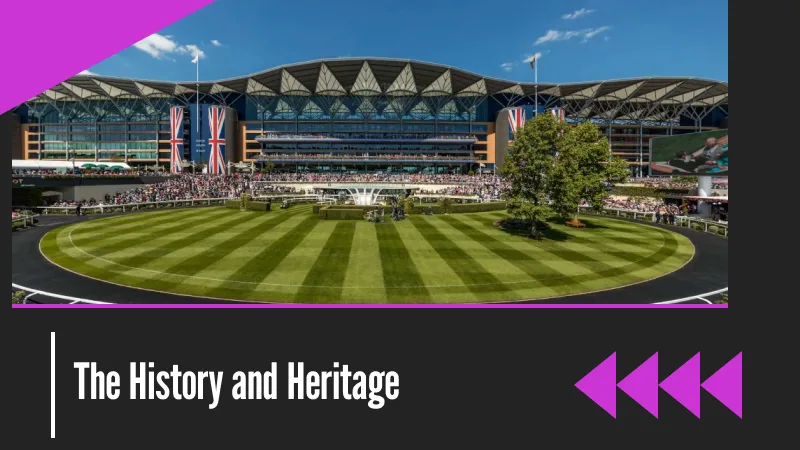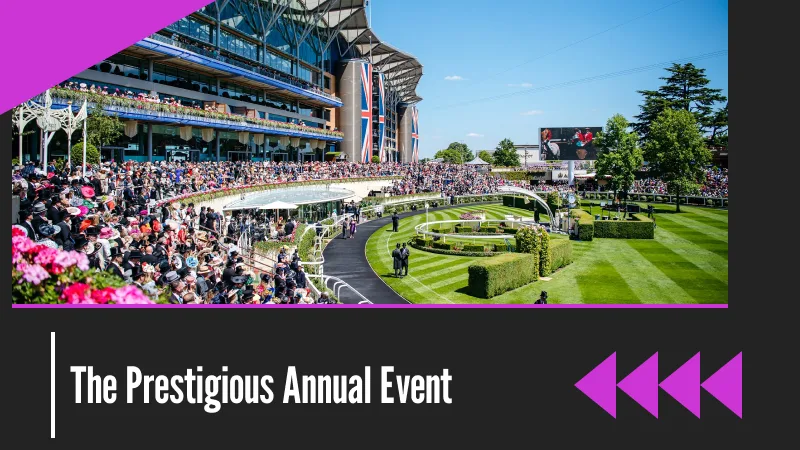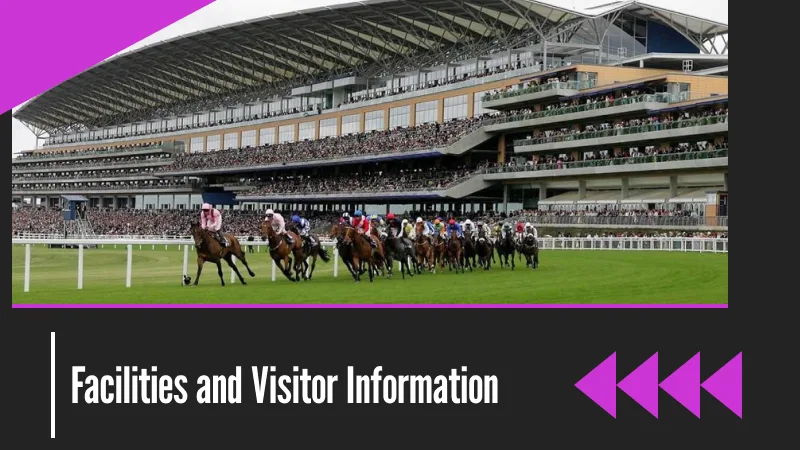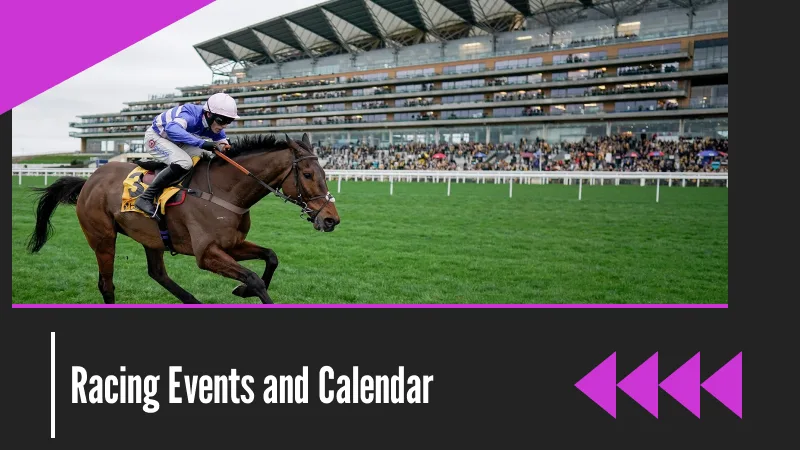Discover Ascot Racecourse, renowned for its rich history, prestigious events, and exceptional facilities. Explore Royal Ascot highlights, iconic architecture, and traditional dress code, offering unforgettable experiences at this famous British horse racing venue.
The History and Heritage of Ascot Racecourse

Ascot Racecourse, a cornerstone of British horse racing venues, was founded by Queen Anne in 1711. The racecourse has evolved over the centuries, cementing its place as one of the most famous British racecourses. Ascot Racecourse History is rich with significant milestones, including hosting the first Royal Ascot in 1768.
The racecourse’s enduring connection to the British monarchy has enhanced its prestige, making it a vital part of Ascot Racecourse Traditions. Known for its architectural evolution, the Ascot Racecourse Architecture reflects modern design while preserving historical elements. As a venue that welcomes around 600,000 visitors annually, it plays a crucial role in Britain’s cultural landscape. Its ongoing legacy is marked by its commitment to excellence in horse racing at Ascot, maintaining an atmosphere where history and tradition thrive alongside contemporary advancements.
Founding by Queen Anne in 1711
The founding of Ascot Racecourse by Queen Anne in 1711 is a landmark event in British horse racing history. During a ride from Windsor Castle, Queen Anne identified the potential of the vast open heathland for horse racing, envisioning a venue where horses could gallop at full stretch. Her vision materialized with the establishment of Ascot Racecourse, designed to host competitive racing events.
The inaugural race, known as Her Majesty’s Plate, was held shortly after its establishment, marking the beginning of a longstanding tradition. This initiative by Queen Anne not only laid the foundation for what would become one of the most famous British racecourses but also anchored the Royal Family’s ongoing association with the sport. The legacy of Ascot Racecourse continues to be celebrated, attracting international attention and maintaining its status as a cultural icon within the realm of horse racing.
Significant Historical Milestones
Ascot Racecourse has witnessed numerous significant historical milestones since its inception in 1711. One of the earliest milestones was the establishment of the Royal Ascot meeting in 1768, which elevated the venue’s status and popularity. The racecourse continued to evolve, with the first grandstand being constructed in 1794, reflecting the growing interest and attendance.
In 1813, an Act of Parliament ensured that Ascot would remain a public racecourse, securing its future for generations. The introduction of the Gold Cup in 1807 became a prestigious highlight, attracting top competitors. As horse racing at Ascot flourished, modernization efforts included the redevelopment of the grandstand in 2006, blending tradition with contemporary design. These milestones underscore Ascot Racecourse’s role as a cornerstone of British horse racing venues, maintaining its reputation as a venue of excellence while preserving its rich history and cultural significance.
Ascot’s Role in British Horse Racing Venues
Ascot Racecourse holds a pivotal role among British horse racing venues, renowned for its rich heritage and contributions to the sport. As one of the most famous British racecourses, Ascot is synonymous with excellence and tradition. It hosts numerous prestigious races throughout the year, including prominent events that attract top-tier competitors from around the globe;
The racecourse’s strategic location near London enhances its accessibility, drawing significant local and international audiences. Ascot’s commitment to maintaining high standards in horse racing at Ascot ensures its continued prominence within the racing community. Furthermore, Ascot Racecourse’s emphasis on preserving traditions while embracing innovation reflects its influential status in shaping the future of British horse racing. Its unique blend of history, competition, and grandeur underscores its enduring legacy as a cornerstone of the industry, captivating enthusiasts and spectators alike with unforgettable experiences.
Royal Ascot⁚ The Prestigious Annual Event

Royal Ascot stands as a prestigious annual event, emblematic of elegance and tradition within British horse racing. Held each June over five days, it captivates worldwide attention with its pageantry and high-caliber races. This iconic event is celebrated for its Royal Enclosure Ascot, where strict dress codes and royal attendees highlight its esteemed status.
Renowned for its competitive spirit, Royal Ascot hosts numerous Group 1 races, including the coveted Gold Cup. Attendees experience not just exceptional horse racing at Ascot but also a vibrant social occasion steeped in history. With nearly 300,000 visitors annually, it showcases the best of British culture and sport, blending regal traditions with modern flair. Royal Ascot’s allure lies in its ability to merge sporting excellence with social prestige, creating an unparalleled atmosphere that continues to enchant spectators year after year.
The Origin of Royal Ascot
The origin of Royal Ascot dates back to 1768, when it was established as a premier racing event in the British social calendar. Initially conceived as an extension of Ascot Racecourse’s prestigious offerings, the event quickly gained popularity due to its royal patronage and high-profile attendance. Over the years, Royal Ascot has evolved into a symbol of elegance and tradition, attracting visitors from around the world.
Its inception marked a turning point for Ascot Racecourse, cementing its status as one of the most famous British racecourses. The event’s unique appeal lies in its blend of competitive horse racing at Ascot and vibrant social gatherings, underpinned by the presence of the Royal Family. This historical foundation continues to shape Royal Ascot’s identity, making it a quintessentially British spectacle that celebrates both sporting excellence and cultural heritage.
Royal Ascot Highlights
Royal Ascot is renowned for its highlights, combining thrilling horse racing with opulent social gatherings. One of the key attractions is the Gold Cup, a prestigious race that draws top competitors and captivates audiences with its high stakes and dramatic finishes. The event spans five days, each featuring a unique blend of races, fashion, and tradition.
Among the standout features are the royal processions, where members of the Royal Family arrive in horse-drawn carriages, adding a touch of regal splendor to the occasion. The vibrant atmosphere is further elevated by the presence of the Royal Enclosure, known for its strict dress code and exclusive access. Spectators can enjoy a mix of sporting excellence and luxurious hospitality, making Royal Ascot a must-attend event for enthusiasts and newcomers alike, offering an unforgettable experience steeped in British cultural heritage.
The Importance of the Royal Enclosure Ascot
The Royal Enclosure at Ascot is a cornerstone of British aristocratic tradition, epitomizing elegance and exclusivity. Established in 1807, it originally served as a private viewing area for King George III’s guests and has since become synonymous with prestige. Admission to the Royal Enclosure Ascot is by invitation only, maintaining its aura of exclusivity and allure.
This section of the racecourse is crucial not only for its historical significance but also for enhancing the event’s social prestige. It is here that fashion and formality reach their zenith, with strict dress codes ensuring a dignified atmosphere. The Royal Enclosure enhances the overall experience of Royal Ascot, serving as a focal point for high society and contributing to the unique ambiance that distinguishes this event from other horse racing gatherings, making it an iconic part of Ascot Racecourse events.
Facilities and Visitor Information at Ascot Racecourse

Ascot Racecourse offers extensive facilities designed to enhance the visitor experience, ensuring comfort and convenience. Located in Berkshire, approximately 25 miles from London, its accessibility makes it a prime destination for both local and international guests. The racecourse features modern grandstands with vast seating capacities, allowing spectators to enjoy unobstructed views of the races.
Visitors can choose from a variety of hospitality options, ranging from casual dining to luxurious suites, catering to diverse preferences and budgets. The architecture of Ascot Racecourse combines traditional elegance with contemporary design, reflecting its prestigious reputation. Additionally, ample parking and efficient transport links simplify travel arrangements for attendees.
Whether attending Royal Ascot or other events, visitors are assured of top-tier amenities, including betting facilities, retail outlets, and information centers, all contributing to a seamless and memorable experience at one of Britain’s most iconic horse racing venues.
Ascot Racecourse Location and Accessibility
Ascot Racecourse is strategically located in Ascot, Berkshire, England, approximately 25 miles west of London, making it easily accessible for both local and international visitors. The racecourse is well-connected by various transport options, ensuring a hassle-free journey for attendees. Visitors can reach Ascot by train from London Waterloo, with direct services providing a convenient travel alternative.
For those driving, the racecourse offers ample parking facilities, accommodating guests arriving by car; Additionally, shuttle services and taxis are available from nearby stations, further enhancing accessibility. The surrounding area boasts picturesque countryside, offering a serene backdrop to the vibrant events held at the venue.
Whether attending Royal Ascot or other events, visitors benefit from the racecourse’s prime location and excellent transport links, making it a favored destination for horse racing enthusiasts and socialites alike, keen to experience the grandeur of this renowned venue.
Ascot Racecourse Capacity and Hospitality Options
Ascot Racecourse boasts a remarkable capacity, accommodating up to 70,000 spectators, making it one of the largest British horse racing venues. This extensive capacity ensures that visitors can enjoy the races in a vibrant yet comfortable environment. With numerous seating options, from general admission areas to premium enclosures, Ascot offers something for every preference.
The racecourse is renowned for its diverse hospitality options, catering to a range of tastes and budgets. Visitors can indulge in luxurious experiences within private suites offering panoramic views of the track, or enjoy fine dining in elegant restaurants featuring gourmet menus crafted by renowned chefs. For those seeking a more casual experience, there are various bars and food outlets available throughout the venue.
These hospitality offerings enhance the overall experience, providing guests with an unforgettable day at the races, whether attending Royal Ascot or other prestigious events.
Ascot Racecourse Architecture and Design
Ascot Racecourse is an architectural marvel, blending traditional British elegance with modern design. The grandstand, completed in 2006, is a striking feature, offering a contemporary aesthetic while accommodating thousands of spectators comfortably. Its sweeping lines and extensive use of glass provide unobstructed views of the track, enhancing the spectator experience.
The racecourse’s design pays homage to its rich heritage, incorporating elements that reflect its historical significance as one of Britain’s most famous racecourses. The layout ensures optimal flow and accessibility, allowing visitors to navigate effortlessly between various areas, from viewing platforms to hospitality suites.
Attention to detail is evident throughout the venue, with beautifully landscaped gardens and meticulously maintained grounds adding to the overall allure. Ascot Racecourse’s architecture not only facilitates world-class racing events but also contributes to its reputation as a premier destination for elegance, style, and sophistication.
Racing Events and Calendar at Ascot Racecourse

Ascot Racecourse hosts a diverse range of racing events throughout the year, making it a central hub for British horse racing enthusiasts. The racing calendar is meticulously planned, offering thrilling experiences for both seasoned racegoers and newcomers alike. Annual horse racing at Ascot includes prestigious events such as Royal Ascot, known for its grandeur and high stakes.
In addition to Royal Ascot, the racecourse features numerous notable races, including the King George VI and Queen Elizabeth Stakes, attracting top-tier talent from around the globe. Ascot Racecourse events are not limited to flat racing; they also include jump racing, catering to a wide array of preferences.
The carefully curated schedule ensures that there is always something exciting happening, drawing large crowds and maintaining Ascot’s status as a premier venue in the world of horse racing, celebrated for its tradition and excellence.
Annual Horse Racing at Ascot
Annual horse racing at Ascot Racecourse is a cornerstone of its identity, showcasing the finest in British equestrian sport. Throughout the year, the venue hosts numerous high-profile races that draw spectators from all over the world; The racing season kicks off with the flat racing events, setting the stage for thrilling competitions and outstanding performances by top jockeys and horses.
As the calendar progresses, Ascot seamlessly transitions into jump racing, highlighting the versatility and excitement that different racing formats bring. Each event is meticulously organized, ensuring an unparalleled experience for both participants and visitors. The variety of races held annually caters to diverse preferences, offering something unique for everyone.
Beyond the races themselves, the atmosphere at Ascot Racecourse is electric, filled with anticipation and camaraderie, making it not just a sporting event but a social occasion celebrated by racing enthusiasts and newcomers alike.
Notable Ascot Racecourse Races
Ascot Racecourse is synonymous with some of the most notable races in the world of horse racing, each contributing to its esteemed reputation. The Queen Anne Stakes, traditionally opening Royal Ascot, is a highlight featuring elite competitors. Another prestigious race is the Gold Cup, renowned for testing stamina and endurance, making it a centerpiece of Royal Ascot.
The King George VI and Queen Elizabeth Stakes stand out as a mid-summer classic, attracting top-tier thoroughbreds from across the globe. These races are not only significant for their competitive nature but also for the history and prestige they embody, drawing large audiences and media attention.
These notable races are integral to Ascot’s identity, offering thrilling spectacles that combine tradition, excellence, and the finest equestrian talent, ensuring Ascot Racecourse remains at the forefront of British horse racing culture and heritage.
Ascot Racecourse Events Throughout the Year
Ascot Racecourse hosts a dynamic array of events throughout the year, offering diverse experiences for visitors. While Royal Ascot is the pinnacle event, the racecourse also schedules an impressive variety of other racing and social occasions. The flat racing season starts in spring, bringing intense competition and vibrant energy.
As the year progresses, Ascot transitions into jump racing, providing thrilling spectacles for enthusiasts. The Summer Mile Weekend and King George VI Weekend are standout highlights, featuring exciting races that attract top competitors. Additionally, the Autumn Racing Weekend offers a unique blend of competitive races and festive atmosphere.
Beyond racing, Ascot hosts non-racing events, including concerts and exhibitions, showcasing its versatility as a venue. This year-round calendar ensures that Ascot remains a lively hub for entertainment, continuing to draw large crowds and maintaining its status as an essential part of British cultural life.
Ascot Racecourse Dress Code and Royal Enclosure Etiquette
The Ascot Racecourse dress code is a celebrated tradition, reflecting its prestigious status. Visitors are encouraged to embrace elegance, with specific guidelines ensuring an atmosphere of sophistication. In the Royal Enclosure, strict attire rules apply⁚ men must wear morning dress in black or grey with a top hat, while women should don formal daywear with hats or fascinators.
For other enclosures, smart attire is required, promoting refinement without being overly prescriptive. The dress code emphasizes the event’s grandeur and enhances the overall experience for attendees. Understanding these expectations ensures guests fully appreciate the cultural and social significance attached to attending events at Ascot Racecourse.
Beyond clothing, etiquette within the Royal Enclosure demands respect for traditions and decorum, fostering an environment of exclusivity and charm. This combination of dress code and etiquette enriches the heritage and allure of Ascot’s renowned race meetings.
Traditional Dress Code Requirements
The traditional dress code requirements at Ascot Racecourse are central to its longstanding heritage and charm, ensuring an elegant and distinguished atmosphere. For gentlemen, the Royal Enclosure demands morning dress in black or grey, including a waistcoat, tie, and top hat, epitomizing classic British style. Ladies must wear formal daywear with hemlines below the knee, complemented by hats or substantial fascinators, embodying sophistication.
In other enclosures, smart attire is expected⁚ men typically wear suits with ties, while women opt for dresses or skirts of modest length, paired with stylish headpieces. This dress code not only honors tradition but enhances the visual spectacle of Ascot events, contributing to their unique allure.
Adhering to these requirements reflects respect for Ascot’s cultural significance and ensures guests fully engage in the prestigious ambiance that defines this iconic venue and its celebrated gatherings.
Etiquette within the Royal Enclosure
The Royal Enclosure at Ascot Racecourse is a symbol of prestige and tradition, requiring adherence to specific etiquette that enhances its exclusive atmosphere. Guests are expected to maintain decorum, reflecting the enclosure’s storied history and esteemed standing. Politeness and courtesy are paramount, with conversations conducted in respectful tones.
Photography should be discreet, ensuring it does not disrupt the enjoyment of others. Mobile phones are encouraged to be used sparingly, fostering an environment focused on the event and social interaction. Punctuality is also important, as it respects both fellow guests and the schedule of races and events.
This etiquette underscores the values of the Royal Enclosure, creating a refined experience for all attendees. Observing these guidelines ensures participants honor the legacy of Ascot, contributing to the timeless elegance and charm that define this cherished aspect of British culture.
Impact of Dress Code on Ascot Racecourse Events
The dress code at Ascot Racecourse significantly impacts the overall ambiance and experience of its events, infusing them with a sense of grandeur and tradition. By upholding stringent attire standards, Ascot events are elevated to occasions of elegance, where fashion becomes an integral part of the spectacle.
This emphasis on formal dress fosters an environment of sophistication, attracting visitors who appreciate both racing and sartorial excellence. The visual appeal created by attendees in their finest attire enhances the prestige of the racecourse, contributing to its reputation as a premier venue for horse racing and social gatherings.
Moreover, the dress code underscores the cultural significance of Ascot, reinforcing its status as a cornerstone of British heritage. It shapes the identity of the event, ensuring that Ascot remains synonymous with style, tradition, and timeless elegance, creating memorable experiences for all who attend.
